How to protect plants from extreme heat requires implementing several strategic measures.
One vital step to protecting plants from extreme heat is the application of a layer of organic mulch around the plant base, which acts as a shield, maintaining soil moisture and moderating temperature fluctuations. To ensure optimal hydration, water deeply either early in the morning or late in the evening, steering clear of the scorching midday sun. It’s advisable to direct the water to the plant’s base to prevent the leaves from getting wet, which can lead to sunburn. Utilizing shade cloth or employing row covers during the peak heat hours can provide much-needed respite, effectively reducing stress induced by intense sunlight.
Auto Amazon Links: Could not resolve the given unit type, . Please be sure to update the auto-insert definition if you have deleted the unit.
Furthermore, creating microclimates by grouping plants can prove highly beneficial. This practice not only fosters a natural shading effect but also conserves moisture by minimizing evaporation. Reflective mulches, such as those in silver or white hues, can deflect excess sunlight, preventing overheating. Additionally, positioning heat-sensitive plants in areas with partial shade or under the canopy of taller plants can offer natural protection against extreme heat. Enhancing the soil with organic matter, like compost, enhances its ability to retain moisture and withstand heat stress.
Prioritizing the hydration of the most susceptible plants during extreme heat is crucial. It’s advisable to avoid fertilizing plants during this period, as fertilizers can stimulate growth that requires more energy and water, exacerbating stress. Regular pruning to eliminate dead or damaged leaves and branches promotes better air circulation, reducing the overall stress load on plants. Windbreaks, such as fences or temporary barriers, can shield plants from both high temperatures and drying winds.
Incorporating misting systems or sprinklers during the hottest part of the day can create a cooling effect, alleviating heat stress. Continuous vigilance is essential; closely monitor plants for signs of distress, such as wilting, browning, or drooping leaves. By promptly adjusting your care routine based on these observations, you can effectively shield your plants from the adverse impacts of extreme heat. Employing a combination of these strategies ensures your plants have the best chance to thrive even in the face of harsh climatic conditions.
Auto Amazon Links: Could not resolve the given unit type, . Please be sure to update the auto-insert definition if you have deleted the unit.
Here is a breakdown of ways to protect plants from extreme heat:
- Mulching: Apply a layer of organic mulch, such as straw, wood chips, or compost, around the base of your plants. Mulch helps to retain soil moisture, regulate soil temperature, and reduce weed competition.
- Watering: Water your plants deeply and consistently, preferably early in the morning or late in the evening when the sun is less intense. Water at the base of the plants to avoid wetting the leaves, which can lead to sunburn. Consider using a soaker hose or drip irrigation system to minimize water wastage.
- Shade Cloth: Use shade cloth or row covers to provide temporary shade for your plants during the hottest part of the day. This can significantly reduce the stress caused by intense sunlight.
- Create Microclimates: If possible, plant heat-sensitive plants in areas that receive partial shade or dappled sunlight. You can also strategically place taller plants to provide shade for shorter ones.
- Use Reflective Mulch: Reflective mulch, such as silver or white plastic, can help bounce sunlight away from plants and keep the soil cooler.
- Group Plants: Planting in groups or clusters can create a microclimate where plants can shade each other and conserve moisture.
- Apply Organic Matter: Adding organic matter like compost to the soil can improve its water-holding capacity and structure, making it more resilient to heat stress.
- Hydration Prioritization: In times of extreme heat, prioritize watering your most sensitive or valuable plants. Some plants can tolerate heat better than others.
- Avoid Fertilizing: During periods of extreme heat, it’s best to avoid fertilizing your plants. Fertilizers can stimulate growth that requires more water and energy, which can stress the plant further.
- Pruning: Remove any dead or damaged leaves and branches. Pruning can improve air circulation around the plants and reduce the overall stress load.
- Use Windbreaks: If you’re in an area prone to high winds along with heat, consider using windbreaks like fences or temporary barriers to reduce drying winds.
- Mist or Sprinklers: Mist the plants or use sprinklers during the hottest part of the day to create a cooling effect. This is more effective in low-humidity conditions.
- Monitor and Adjust: Regularly monitor your plants for signs of heat stress, such as wilting, browning, or drooping leaves. Adjust your care routine accordingly.
Remember that not all plants have the same heat tolerance, so it’s important to consider the specific needs of each type of plant in your garden.


































